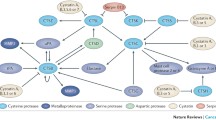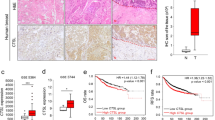Abstract
Cells that migrate away from a central tumour into brain tissue are responsible for inefficient glioblastoma treatment. This migratory behaviour depends partially on lysosomal cysteine cathepsins. Reportedly, the expression of cathepsins B, L and S gradually increases in the progression from benign astrocytoma to the malignant glioblastoma, although their specific roles in glioma progression have not been revealed. The aim of this study was to clarify their specific contribution to glioblastoma cell invasion. The differences between the matrix invading cells and non-invading core cells from spheroids derived from glioblastoma cell culture and from glioblastoma patients’ biopsies, and embedded in type I collagen, have been studied at the mRNA, protein and cathepsin activity levels. Analyses of the two types of cells showed that the three cathepsins were up-regulated post-translationally, their specific activities increasing in the invading cells. The cystatin levels were also differentially altered, resulting in higher ratio of cathepsins B and L to stefin B in the invading cells. However, using specific synthetic inhibitors and silencing strategies revealed that only cathepsin B activity was involved in the invasion of glioblastoma cells, confirming previous notion of cathepsin B as tumour invasiveness biomarker. Our data support the concept of specific roles of cysteine cathepsins in cancer progression. Finally the study points out on the complexity of protease regulation and the need to include functional proteomics in the systems biology approaches to understand the processes associated with glioma invasion and progression.






Similar content being viewed by others
Abbreviations
- CatB:
-
cathepsin B
- CatL:
-
cathepsin L
- CatS:
-
cathepsin S
- CysC:
-
cystatin C
- ECM:
-
extracellular matrix
- GBM:
-
Glioblastoma (multiformae)
- PXA:
-
Pleomorphic xanthoastrocytoma
- StefA:
-
stefin A
- StefB:
-
stefin B
References
Ohgaki H, Kleihues P (2005) Epidemiology and etiology of gliomas. Acta Neuropathol 109(1):93–108
Sathornsumetee S, Rich NJ (2006) New treatment strategies for malignant gliomas. Expert Rev Anticancer Ther 6(7):1087–1104
Rao JS (2003) Molecular mechanisms of glioma invasiveness: the role of proteases. Nat Rev Cancer 3(7):489–501
Demuth T, Berens M (2004) Molecular mechanisms of glioma cell migration and invasion. J Neurooncol 70(2):217–228
Wang W, Goswami S, Sahai E et al (2005) Tumour cells caught in the act of invading: their strategy for enhanced cell motility. Trends Cell Biology 15(3):138–145
Sahai E (2005) Mechanisms of cancer cell invasion. Curr Opin Genet Dev 15(1):87–96
Mariani L, Beaudry C, McDonough WS et al (2001) Glioma cell motility is associated with reduced transcription of proapoptotic and proliferation genes: a cDNA microarray analysis. J Neurooncol 53(2):161–176
Demuth T, Rennert JL, Hoelzinger DB et al (2008) Glioma cells on the run- the migratory transcriptome of 10 human glioma cell lines. BMC Genomics 9:54
Berens ME, Rief MD, Loo MA, Giese A (1994) The role of extracellular matrix in human astrocytoma migration and proliferation studied in a microliter scale assay. Clin Exp Metastasis 12(6):405–415
Hoelzinger DB, Nakada M, Demuth T et al (2008) Autotaxin: a secereted autocrine/paracrine factor that promotes glioma invasion. J Neurooncol 86(3):297–309
Wolf K, Friedl P (2005) Functional imaging of pericellular proteolysis in cancer cell invasion. Biochemie 87(3–4):315–320
Tu C, Ortega–Cava CF, Chen G et al (2008) Lysosomal cathepsins B participates in the podosome-mediated extracellular matrix degradation and invasion via secreted lysosomes in the v-Src fibroblasts. Cancer Res 86(22):9147–9156
Lopez–Otin C, Matrisian LM (2007) Emerging roles of proteases in tumour suppression. Nature Rev Cancer 7(10):800–808
Levičar N, Nuttall RL, Lah TT (2003) Proteases in brain tumour progression. Acta Neurochir (Wien) 145(9):825–838
Lah TT, Duran Alonso MB, Van Noorden CJ (2006) Antiprotease therapy in cancer: hot or not? Expert Opin Biol Ther 6(3):257–279
Rempel SA, Rosenblum ML, Mikkelsen T et al (1994) CathepsinB expression and localization in glioma progression and invasion. Cancer Res 54(23):6027–6031
Lah TT, Strojnik T, Levičar N et al (2000) Clinical and experimental studies of cysteine cathepsins and their inhibitors in human brain tumors. Int J Biol Markers 15(1):90–93
Strojnik T, Kos J, Židanik B, Lah TT (1999) Cathepsin B immunohistochemical staining in tumour and endothelial cells is a new prognostic factor for survival in patients with brain tumours. Clin Cancer Res 5(3):559–567
Strojnik T, Kavalar R, Trinkaus M, Lah TT (2005) Cathepsin L in glioma progression: comparison with cathepsin B. Cancer Detect Prev 29(5):448–455
Sivarapathi M, Yamamoto M, Nicolson GL et al (1996) Expression and immunohistochemical localization of cathepsin L during progression of human gliomas. Clin Exp Metastasis 14(1):27–34
Flannery T, Gibson D, Mirakhur M et al (2003) The clinical significance of cathepsin S expression in human astrocytomas. Am J Pathol 163(1):175–182
Flannery T, McQuaid S, McGoohan C et al (2006) Cathepsin S expression: An independent prognostic factor in glioblastoma tumours-A pilot study. Int J Cancer 119(4):854–860
Kos J, Lah TT (2006) Cystatins in cancer. In: Zerovnik E, Kopitar-Jerala N (eds) Human Stefins and Cystatins. Nova Science Publishers Inc, New York
Abrahamson M (1994) Cystatins. Methods Enzymol 244:685–700
Lignelid H, Collins VP, Jacobsson B (1997) Cystatin C and transthyretin expression in normal and neoplastic tissues of the human brain and pituitary. Acta Neuropathol 93(5):494–500
Nakabayashi H, Hara M, Shimuzu K (2005) Clinicopathologic significance of cystatin C expression in gliomas. Hum Pathol 36(9):1008–1015
Konduri SD, Yanamandra N, Siddique K et al (2002) Modulation of cystatin C expression impairs the invasive and tumorigenic potential of human glioblastoma cells. Oncogene 21(57):8705–8712
Bervar A, Zajc I, Sever B et al (2003) Invasiveness of transformed human breast epithelial cell lines is related to cathepsin B and inhibited by cysteine proteinase inhibitors. Biol Chem 384(3):447–455
Zajc I, Hreljac I, Lah T (2006) Cathepsin L affects apoptosis of glioblastoma cells: a potential implication in the design of cancer therapeutics. Anticancer Res 26(5A):3357-64
Hegedüs B, Marga F, Jakab K et al (2006) The Interplay of Cell-Cell and Cell-Matrix Interactions in the Invasive Properties of Brain Tumors. Biophys J 91(7):2708–2716
Corcoran A, De Ridder LI, Del Duca D et al (2003) Evolution of the brain tumour spheroid model: transcending current model limitations. Acta Neurochir (Wien) 145(9):819–824
Rubenstein BM, Kaufman LJ (2008) The role of extracellular matrix in glioma invasion:a cellular potts model approach. Biophys J 95(12):5661–5680
Gondi CS, Kandhukuri N, Kondraganti S et al (2006) RNA interference–mediated simultaneous down-regulation of urokinase-type plasminogen activator receptor and cathepsin B induces caspase-mediated apoptosis in SNB 19 human glioma cells. Mol Cancer Ther 5(12):3197–3208
Gocheva V, Zeng W, Ke D et al (2006) Distinct role for cysteine cathepsin genes in multistage tumourigenesis. Genes Dev 20(5):543–556
Reinheckel T, Gocheva V, Peters C, Joyce JA (2008) Roles of cysteine proteases in tumour progression: Analysis of cysteine cathepsins knockout mice in cancer models. In: Edwards D, Hoyer-Hansen G, Blasi F, Sloane BF (eds) The Cancer Degradome. Springer Science + Business Media, New York
Lakka C, Gondi CS, Yanamandra N et al (2004) Inhibition of cathepsin B and MMP-9 gene expression in glioblastoma cell line via RNA interference reduces tumour cell invasion, tumour growth and angiogenesis. Oncogene 23(27):4681–4689
Premzl A, Zavasnik-Bergant V, Turk V, Kos J (2003) Intracellular and extracellular cathepsin B facilitate invasion of MCF-10A neoT cells through reconstituted extracellular matrix in vitro. Exp Cell Res 283(2):206–214
Klose A, Wilbrand-Hennes A, Zigrino P et al (2006) Contact of high-invasive, but not low-invasive, melanoma cells to native collagen I induces the release of mature cathepsin B. Int J Cancer 118(11):2735–2743
Podgorski I, Linebough BE, Sameni M et al (2005) Bone microenvironment modulates expression and activity of cathepsin B in prostate cancer. Neoplasia 7(3):207–223
Sameni M, Dosescu J, Sloane BF (2001) Imaging proteolysis by living human glioma cells. Biol Chem 382(5):785–788
Zhu DM, Uckun FM (2000) Z-Phe-Gly-NHO-Bz, an inhibitor of cysteine cathepsins, induces apoptosis in human cancer cells. Clin Cancer Res 6(5):2064–2069
Felbor U, Kesseler B, Mothes W et al (2002) Neuronal loss and brain atrophy in mice lacking cathepsins B and L. Proc Natl Acad Sci USA 99(12):7883–7888
Levičar N, Dewey RA, Daley E et al (2003) Selective supression of cathepsin L by antisense cDNA impairs human brain tumor cell invasion in vitro and promotes apoptosis. Cancer Gene Ther 10(2):141–151
Castino R, Pace D, Démoz M et al (2002) Lysosomal proteases as potential targets for the induction of apoptotic cell death in human neuroblastomas. Int J Cancer 97(6):775–779
Bellail AC, Hunter SB, Brat DJ et al (2004) Microregional extracellular matrix heterogeneity in brain modulates glioma cell invasion. Int J Biochem Cell Biol 36(6):1046–1069
Acknowledgements
We are grateful to Seyed Y. Ardebili, M.D., for providing us with human tumour samples, to Dr. Janko Kos for providing the ELISA kits and primary antibodies, to Dr. Nobuhiko Katunuma for providing Clik 148, to Dr. Irena Zajc and Dr. Simon Caserman for their scientific and technical contributions to this work, and to Dr. Roger Pain for critical reading of the manuscript.
Author information
Authors and Affiliations
Corresponding author
Rights and permissions
About this article
Cite this article
Gole, B., Durán Alonso, M.B., Dolenc, V. et al. Post-Translational Regulation of Cathepsin B, but not of Other Cysteine Cathepsins, Contributes to Increased Glioblastoma Cell Invasiveness In Vitro . Pathol. Oncol. Res. 15, 711–723 (2009). https://doi.org/10.1007/s12253-009-9175-8
Received:
Accepted:
Published:
Issue Date:
DOI: https://doi.org/10.1007/s12253-009-9175-8




